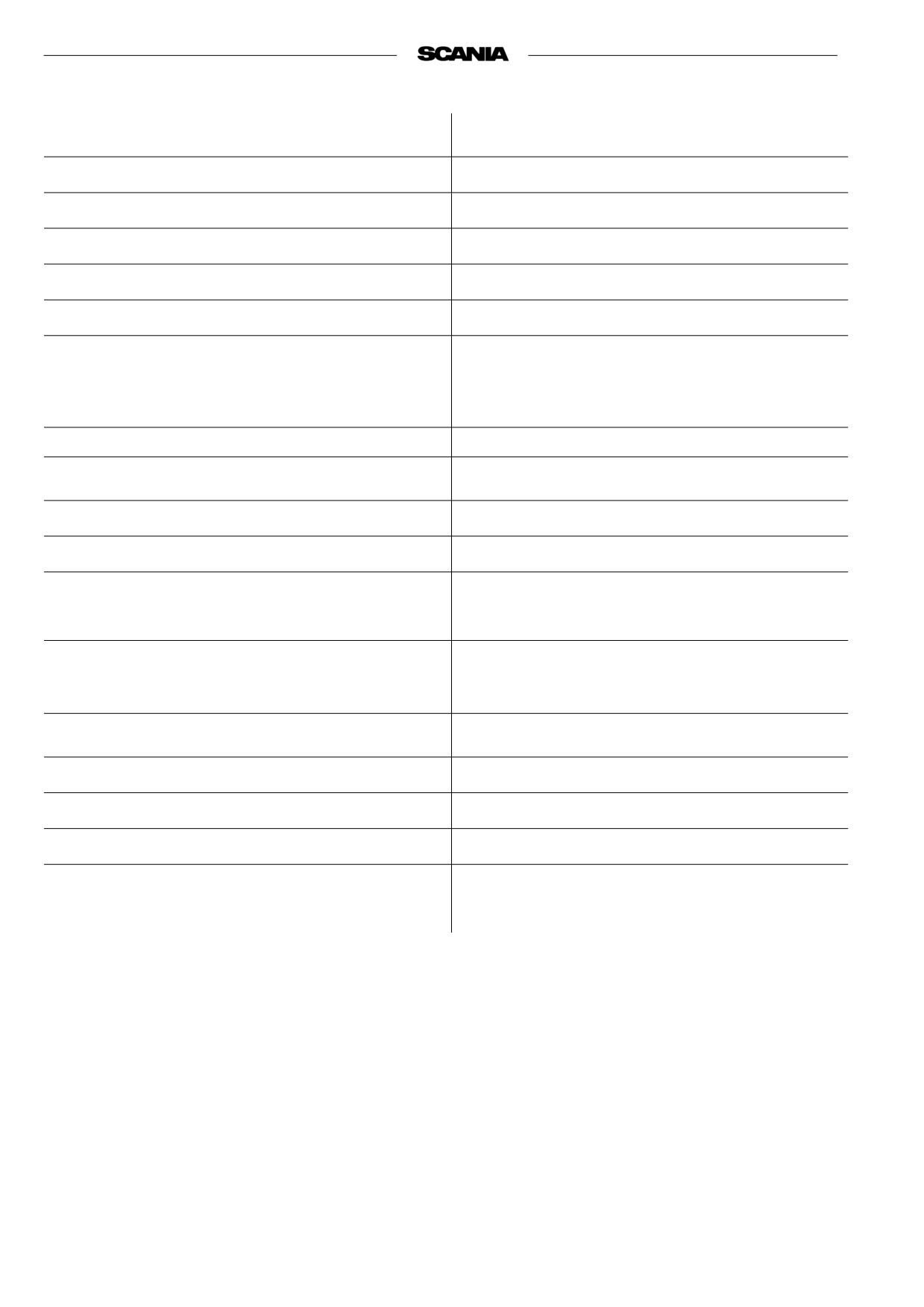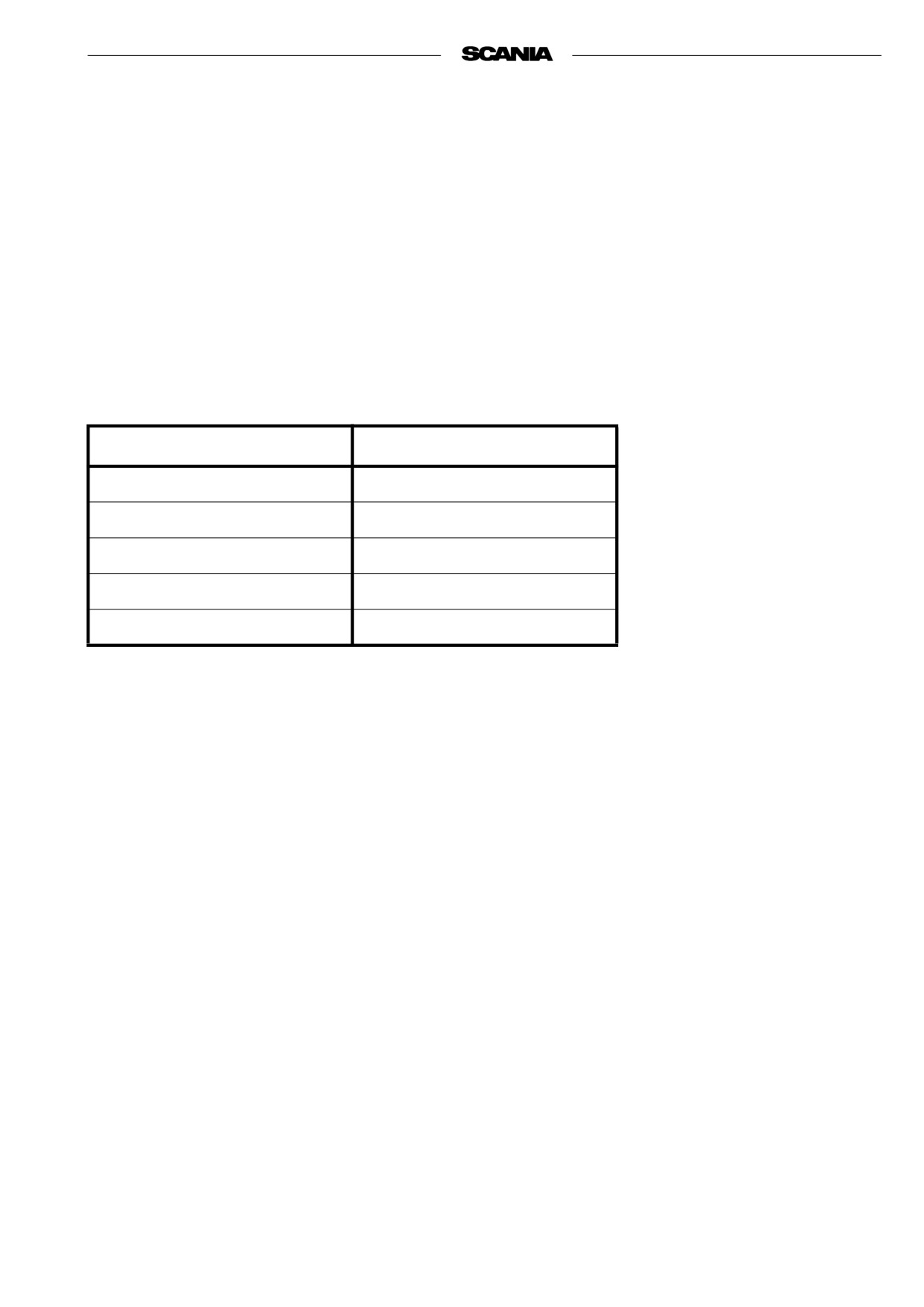Scania DI14. Marine engine. Operator’s manual - part 4
- Attach a label to the engine showing the date of preservation and
clearly stating that it must not be started or cranked.
STORED ENGINE
Date
Do not start or crank!
Batteries
Remove the batteries for trickle charging at a charging station. (This does not
Wear gloves and eye protection
apply to batteries which, according to the manufacturer, are maintenance free.)
when charging and handling
The same is applicable for short-term storage if the engine has not been pre-
batteries.
pared for storage as above.
Batteries contain a highly
Storage
corrosive acid.
After the preparations, the engine should be stored in a dry and warm place
(room temperature).
Taking out of storage
(Procedure when the engine is to be put into operation)
- Remove plugs and tape from coolant connections, air intakes and exhaust
pipes.
- Fill the system with coolant, see page 12.
- Check the oil level in the engine or top up with new motor oil.
Always use suitable containers
- Turn the engine over a few times with the injectors removed, at the same
to avoid spillage when
time copiously oiling the valve mechanism with pushrods and tappets.
draining oil and coolant.
Important The engine must be turned over with the injectors removed so
Dispose of used oil and coolant
that surplus preservative oil will be pressed out of the cylinders.
through an authorized waste
disposal contractor.
- Fit the injectors.
- Empty the fuel system main filter of preservative oil.
- Bleed the fuel system.
- Wash off any externally applied preservative oil, using white spirit.
48

TECHNICAL DATA
GENERAL
DI14
Number of cylinders
V8, 90°
Cylinder bore
mm
127
Stroke
mm
140
Displacement
dm3 (litres)
14.2
Number of main bearings
5
Firing sequence
1 - 5 - 4 - 2 - 6 - 3 - 7 - 8
Compression ratio
15:1
High output engine:13.5:1
Engine direction of rotation viewed from rear
Anti-clockwise
Fan direction of rotation viewed from the front
Anti-clockwise
Cooling
Fluid
Valve clearance, cold engine:
intake valve
mm
0.45
exhaust valve
mm
0.80
Weight (without coolant and oil)
engine with heat exchanger
kg
1400
engine without heat exchanger (keel-cooling)
kg
1325
Output
see “Engine record card”
LUBRICATION SYSTEM
Max. oil pressure
(warm engine at speed above 800 rpm) bar (kp/cm2)
6
Normal oil pressure
(warm engine at operating speed)
bar (kp/cm2)
3 - 6
Min. oil pressure
(warm engine 800 rpm)
bar (kp/cm2)
0.7
Oil capacity, see page 21.
Crankcase pressure with closed crankcase
ventilation
mm VP
-55 - +20
49

FUEL SYSTEM
DI14
Pump setting BTDC
See plate on rocker cover
Injectors, opening pressure
bar (kp/cm2)
300
Low idle
rpm
700
Maximum full load speed
See engine card
Fuel
Diesel fuel oil1)
Tightening torques:
Socket nut for injectors
Nm
70
Cap nut for delivery pipe
Nm
20
Oil leakage connection
Nm
11
1) see page 51
COOLING SYSTEM
Number of thermostats
2
Thermostat, opening temperature
°C
79
Coolant temperature:
system with atmospheric pressure
°C
70 - 93
system with positive pressure
°C
70 - about 100
Capacity
with heat exchanger
dm3 (litres)
93
without heat exchanger (keel-cooling)
dm3 (litres)
50
ELECTRICAL SYSTEM
System voltage
V
24
Alternator, current
A
65 or 120 or 2x65
Starter motor power
kW (hp)
6,7 (9,1)
Monitors, settings:
oil pressure monitor
bar (kp/cm2)
2-pole: 0.7 ± 0.15
temperature monitor
°C
Stamped on monitor hexagon
50

FUEL
Diesel fuel
The composition of the diesel fuel is vitally important to the operation and
life of the engine and the fuel injection pump. The engine power output and
the exhaust emissions are also dependent on the fuel quality.
The requirements and the test standards for the most important properties are
described in the workshop manual in sections that can be ordered from your
Scania dealer or directly from Scania. The address of Scania is printed on the
cover.
The diesel fuel shall comply with the following standard:
EN 590 (European standard).
The table below shows the requirements for some of the most important
properties:
Property
Requirement
Viscosity at 40°C
2.0 - 4.5 mm2/s (cSt)
Density at 15°C
0.82 - 0.86 kg/dm3
Sulphur (concentration by mass)
max. 0.3%
Ignitability (CET rating)
min. 49
Flashpoint
56°C
Environmentally favourable fuels (low sulphur fuels)
There are three different grades of so called environmentally favorable fuels
(SS15 54 35). Grade 1 is sulphur-free and grade 2 is low in sulphur.
Compared with class 3 (normal fuel), these fuels are less dense and this
reduces engine power output. Only class 1 fuel should be used with a
catalytic converter.
Short term use of fuel with a higher sulphur content than 0.05% by weight
will not cause permanent damage to the catalytic converter.
The catalytic converter may, however, require fuel with low sulphur content
for some time after this to regain its normal efficiency.
51
Temperature dependence of diesel fuel
At temperatures lower than those specified for the diesel fuel, paraffin wax
may precipitate from the fuel and block filters and pipes. The engine can then
loose power or stop.
The diesel fuel is adapted for use in the specific climate of each country.
It is not permitted to mix
If a vehicle or an engine is to be operated in a temperature zone with lower
kerosene with diesel fuel that is
temperature than normal, first identify the temperature properties of the
already adapted for the climate
fuel concerned.
concerned. The injection pump
The properties of the fuel when cold can be improved by adopting one of the
may be damaged. All use of
following measures before the temperature drops:
paraffin other than kerosene is
- If the fuel concerned is not intended for the expected temperature and no
forbidden, as it causes
diesel fuel with the correct temperature properties is available, we
engine damage.
recommend that an electric fuel heater be installed as a preventative
measure.
- The low temperature properties of diesel fuel may be improved by
adding kerosene as a preventative measure. A maximum of 20% may
be added. When refuelling, the kerosene should be added first, so that it
mixes thoroughly with the diesel fuel.
It is not permissible to mix
Note It is prohibited to use kerosene in engine fuel in some countries.
petrol with diesel fuel. Petrol
- To prevent water in the fuel from freezing and forming ice, maximum
may cause wear to the fuel
0.5-2% alcohol (isopropanol) may be added.
injection pump and it may also
Drain fuel tanks and drain or renew fuel filters at regular intervals.
cause damage to the engine.
52
INDEX
Air cleaner, low pressure indicator
32
Maintenance
18
Air cleaner, pre-filter
32
Maintenance schedule
19
Air cleaner, safety cartridge
34
Air filter, insert
32
Oil analysis
20
Oil capacity
21
Battery, changing
42
Oil change
21
Bleeding, fuel system
35
Oil cleaner
22
Oil grade
20
Certified engines
5
Oil level
21
Checks after running
17
Oil pressure
16
Checks before running
13
Clutch
17
Pre-filter, air cleaner
32
Coolant
26
Protection against corrosion
28
Coolant level
24
Coolant level monitor
38
Running
15
Coolant temperature
15
Coolant temperature monitor
39
Safety cartridge, air cleaner
34
Coolant, changing
28
Safety details
6
Cooling system, cleaning
29
Safety precautions for care and maintenance . . 8
Safety precautions for handling materials
8
Emergency stop
16
Safety precautions for operation
7
Environmental responsibility
4
Speed
15
Starting the engine
13
Filter, air cleaner
32
Start-up report
1
Filter, fuel
35
Stop solenoid
41
First start
12
Stopping the engine
16
Foreword
2
Storage
48
Fuel filter, changing
35
Fuel level
35
Taking out of storage
48
Fuel specifications
51
Technical data
49
Fuel system, bleeding
35
Temperature monitor
39
Turbo filter
24
Glycol
26
Type designations
10
Injectors
36
Valve clearance
44
Leakage
43
Warranty
1
Low pressure indicator
32
Lubrication oil pressure
16
53